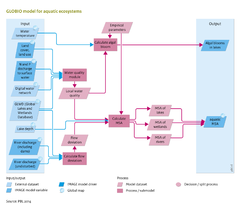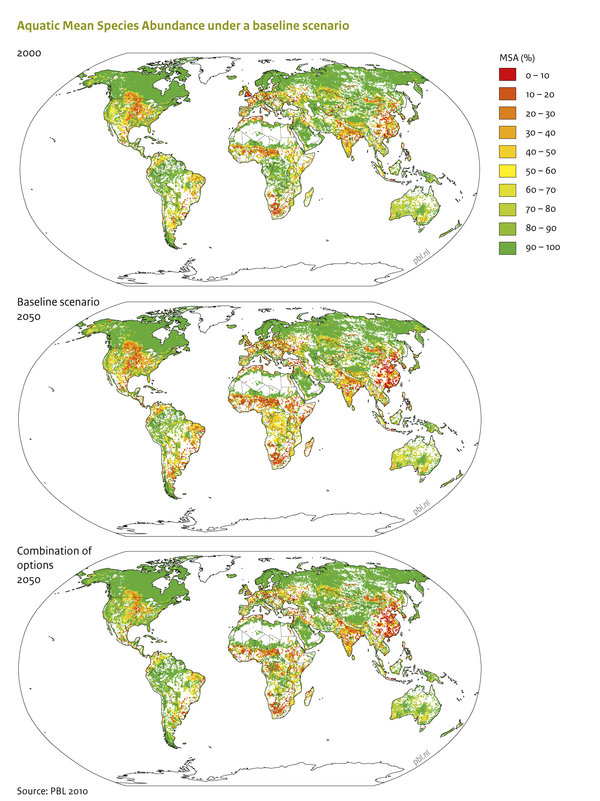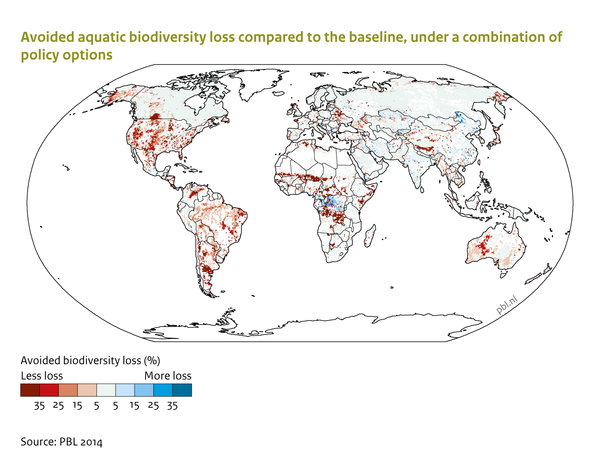Aquatic biodiversity/Policy issues
Parts of Aquatic biodiversity/Policy issues
| Component is implemented in: |
|
| Projects/Applications |
| Models/Databases |
| Key publications |
| References |
Baseline developments
The GLOBIO model for aquatic ecosystems simulates average biodiversity intactness (MSA) in freshwater biomes under different baseline assumptions (assuming no new policies). Considerable decline in MSA is projected for most regions, and will continue throughout the 2010–2050 period, particularly in Africa (PBL, 2010; PBL, 2012); see the figure below. The simulated declines are likely to be underestimated because the effects of wetland reclamation and future planned river dams and climate change have not yet been included in these projections. Algal bloom in lakes due to eutrophication with phosphorus and nitrogen will also increase.
Policy interventions
Decline in MSA value of future aquatic biodiversity can be prevented using a combination of options. These options include expansion of protected areas, reduction of agricultural area by means of consumption changes and reduced food losses, increase in agricultural productivity, and improved efficiency of nutrient use while reducing emissions. IMAGE calculations show this combination of options may even induce some recovery of biodiversity already lost in selected locations: increasing MSA), see the figure above). This may be counteracted by the effects of climate change (Mooij et al., 2005; Jeppesen et al., 2009). With respect to agricultural intensification, there may be a trade-off between increased biodiversity loss on local scale and decreased loss on catchment scale.
Effects of policy interventions on this component
| Policy intervention | Description | Effect |
|---|---|---|
| Changes in consumption and diet preferences | Interventions that target consumption changes or changes in dietary preferences (Reference:: Stehfest et al., 2013) | Changes in agricultural land use affects nutrient leaching to water bodies. |
| Changes in crop and livestock production systems | General changes in crop and livestock production systems, e.g. more efficient production methods to create higher production per unit of input, or other systems like organic farming | On one hand the increase of productivity increases nutrient leaching to water bodies, on the other hand a smaller agricultural area is needed, reducing the pressures from agriculture. |
| Enlarge protected areas | Increase in areas with protected status, as well the size of the areas as the numer of parks. (Reference:: PBL, 2010) | Lower pressure from agricultural impacts in protected area regions. Outside protected areas this pressure may increase. |
| Hydropower (*) | Construction of dams and reservoirs in rivers (Reference:: Fekete et al., 2010) | Construction of dam and reservoir e.g. for hydropower causes disturbance of river flow leading to loss of habitats and migration routes for aquatic biota. |


